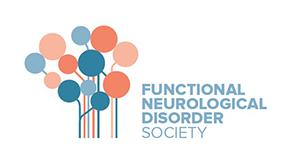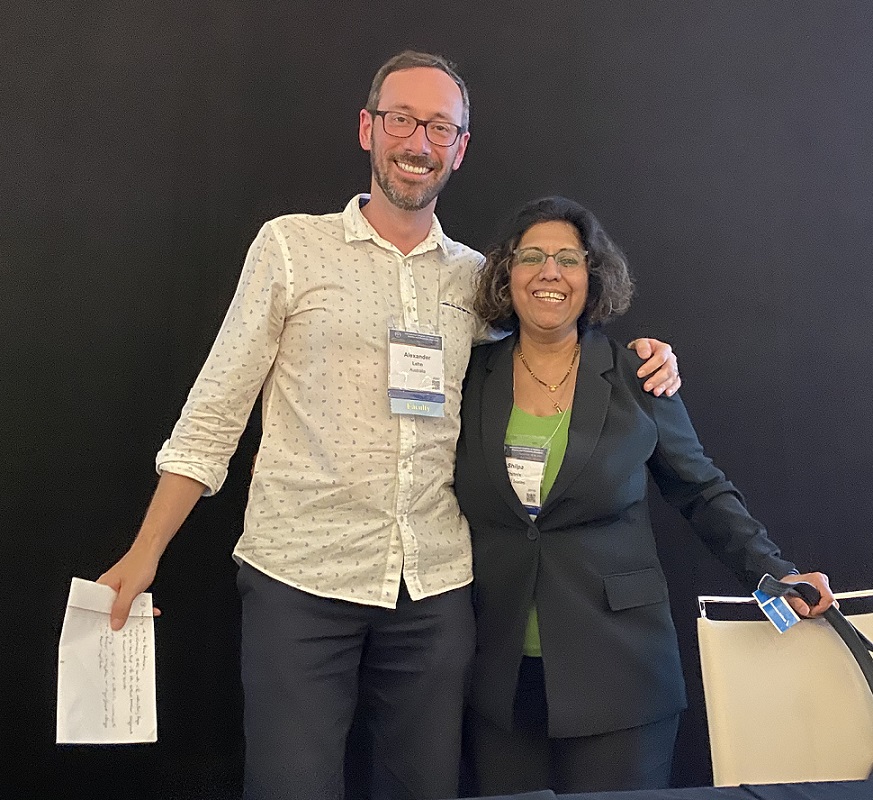| |
 |
| |
|
|
|
|
|
| |
| |
| |
 |
|
|
|
|
|
| |
|
| |
| |
|
2023 Volume 3, Number 1
|
|
|
|
|
|
| |
|
| |
| |
| |
Editor's Note
Greetings Esteemed Readers,
We are delighted to present the first edition of the FNDS Newsletter for 2023. The editorial team is committed to provide our readers with the most recent and relevant information on Functional Neurological Disorders.
In this edition, we have curated a diverse range of content for your perusal. We have included a special interview with Dr. Sara Paredes-Echeverri on her seminal work, “Towards a possible trauma subtype of functional neurological disorder: Impact on symptom severity and physical health.” Furthermore, Dr. Alexander Lehn’s summary of the FND session held at the MDS meeting in September 2022 is also included, providing an overview of the key topics discussed and his expert insights on the subject matter. Finally, Dr. Sanjay Pandey’s examination of Dhat Syndrome as the first in our series of “FND Cultural Specific Syndrome.”
Our objective is to furnish our readers with a comprehensive resource that keeps them informed and engaged with the latest advancements in the field of Functional Neurological Disorders.
We welcome any feedback and suggestions for improvement of our newsletter. Please do not hesitate to contact us with any comments or queries. We hope that you will find this edition informative and engaging.
Sincerely,
The Editorial Team
Functional Neurological Society Newsletter
|
|
| |
|
|
|
|
|
|
|
|
|
|
| |
| |
| |
|
FND session at the Madrid MDS Conference
by Alexander Lehn
|
|
| |
|
|
| |
The 2022 International Congress of Parkinson's Disease and Movement Disorders was held in Madrid, Spain, and approximately 3,000 participants attended from all over the world. As part of the congress, Alberto Espay, Shilpa Chitnis, and I ran a session on the assessment of Functional Movement Disorders (FMDs) in Clinical Practice.
We aimed to make the session as practical as possible. I began by discussing language and wording and provided some data on the relative frequency of Functional Movement Disorders. After explaining the role of the neurologist and why it is essential to get the "front-end" right, Professor Chitnis discussed the diagnostic criteria of FMDs and what is helpful and not helpful in history-taking when assessing patients with FMDs. Professor Chitnis then outlined neurobiological perspectives for Functional Movement Disorders and discussed different clinical presentations of FMDs. She provided an overview of the workup of patients with suspected FMDs, including clinical assessments, electrophysiological studies, and imaging studies. I followed up by discussing general treatment approaches for patients with FMDs and how a tailored therapy approach can look. I then spent some time discussing areas that many of us struggle with: differentiating functional tics and dystonia from their organic counterparts. I discussed typical features of each, along with several case examples to illustrate them further. I then presented a case report of one of my patients where I found it challenging to make the call if this was a functional or organic presentation (or both). I finished off by discussing whether this differentiation still makes sense (at least in certain areas of clinical neurology). Professor Chitnis then wrapped up the didactic part of the session by discussing another tricky topic: how to diagnose Functional overlay.

Left to Right: Alexander Lehn, MD and Shilpa Chitnis, MD, PhD
At the end of the session, we were put to the test with six case presentations and discussions about how to differentiate functional from other (“organic”) neurological disorders based on history, clinical assessments, and investigations. The cases were very interesting and, for me, quite humbling. It turns out it can be quite hard to make the call if you are put on the spot like that!
We had great fun running the session and loved seeing how interested the audience was. For me personally, I enjoyed seeing the MDS highlighting the importance of this topic by regularly providing sessions about Functional Neurological Disorders. It is a great opportunity for us in the FND community to get more people interested and improve patient care across the globe.
|
|
| |
|
|
|
|
|
|
|
| |
|
| |
| |
|
|
| |
|
|
| |
Dhat syndrome - Culture-Bound Syndrome in South Asian Countries
Vikas Gaur, MD1, Sanjay Pandey, MD, DM2
1 Department of Psychiatry, Amrita Hospital, Faridabad, Delhi National Capital Region, India, 121002
2 Department of Neurology, Amrita Hospital, Faridabad, Delhi National Capital Region, India, 121002
Culture-bound syndrome comprises a collection of specific psychological, somatic, and behavioral manifestations that are seen in natives belonging to geographically and culturally limited areas and are considered an illness by most belonging to that culture.
Dhat syndrome is one such cultural-bound syndrome that is widely prevalent in South Asian countries, especially in the Indian subcontinent. Its symptomatology is similar to other culture-bound syndromes such as sukra prameha prevalent in Sri Lanka and shen-kuei prevalent in China, and is characterized by the presence of severe anxiety, depression, sexual symptoms, and hypochondriasis concerns attributed to loss of semen and or whitish discharge in urine. 1,2
The term ‘Dhat’ (metal / medicinal constituent in the Sanskrit language) is considered a powerful constituent of the human body and it is widely believed that Dhat syndrome occurs because of the loss of this Dhat in urine.1
The term ‘Dhat syndrome’ was coined by the late Professor Dr. N.N.Wig in 1960. Patients suffering from Dhat syndrome may present with a polymorphic cluster of symptoms belonging to the affective, cognitive, somatic, and behavioral domains.3 The most commonly reported symptoms are severe anxiety, guilt associated with masturbation and/or night-fall (nocturnal emission), physical weakness, lack of appetite, fatigue, poor concentration, forgetfulness, and vague somatic symptoms, along with a sad or dysphoric mood. These patients also have other coexisting sexual dysfunctions, such as premature ejaculation or impotence. Dhat syndrome is mentioned under the “Other specified neurotic disorders” (F48.8) category in the International Statistical Classification of Diseases and Related Health Problems (ICD-10) and as a ‘Cultural concept of distress” under the glossary section in DSM-V classification. In females, a similar diagnostic entity has been reported, in which female patients present with pathological vaginal discharge along with psychological distress and somatic symptoms.4
Psychological and psychosexual symptoms seen in Dhat syndrome varies widely based on the impact of culture, geography, demographic profile, and socio-economic status of the patients.3 In India, most patients suffering from Dhat syndrome are young males, belonging to rural or semi-urban backgrounds, with a low level of education, and they typically seek consultation during the second or third decade of life. In most cases, friends, colleagues, or relatives are the first source of information with whom the patient enquires or discusses their symptoms, and they conclude that Dhat (whitish discharge) in urine is the possible culprit behind their current symptoms. The majority of patients also have a preconceived notion that one drop of semen is made from 40 – 100 drops of blood, hence loss of semen in any form will lead to weakness in the body.
There is usually a time gap of approximately 6.78 ± 6.94 years before the first consultation with a doctor, and the majority of patients first visit an ayurvedic practitioner or an unqualified doctor before seeing a specialist medical doctor.5 Most patients show poor compliance to treatment, change doctors frequently and have high dropout rates.
The management of Dhat syndrome primarily involves providing sex education, which should include knowledge about body anatomy and physiology of sexual organs, and how they function, with special reference to the production and discharge of semen and secretions from Cowper’s gland. Relaxation therapies, psychotherapy, especially cognitive behavior therapy, have also been found to be useful.
References
- Rao TS. History and mystery of Dhat syndrome: A critical look at the current understanding and future directions. Indian Journal of Psychiatry. 2021 Jul;63(4):317.
- Grover S, Gupta S, Avasthi A. A follow-up study of patients with Dhat syndrome: Treatment pattern, outcome, and reasons for dropout from treatment. Indian Journal of Psychiatry. 2016 Jan;58(1):49.
- Rao TS. History and mystery of Dhat syndrome: A critical look at the current understanding and future directions. Indian Journal of Psychiatry. 2021 Jul;63(4):317.
- Kar SK, Menon V, Arafat SY, Singh A, Das A, Shankar A, Sharma P, Perera S. Dhat syndrome: Systematic review of epidemiology, nosology, clinical features, and management strategies. Asian Journal of Psychiatry. 2021 Nov 1;65:102863.
- Prakash O, Kar SK. Dhat syndrome: a review and update. Journal of Psychosexual Health. 2019 Jul;1(3-4):241-5.
|
|
| |
|
|
|
|
|
|
|
|
|
| |
|
| |
| |
| |
Toward a possible trauma subtype of functional neurological disorder: Impact on symptom severity and physical health
Interview with Dr. Sara Paredes-Echeverri
By Michael Romeo
|
|
| |
In this month's FNDS newsletter, we had the pleasure of interviewing Dr. Sara Paredes-Echeverri about her ground-breaking research into a possible trauma subtype of FND and what this could mean for our understanding of the role of trauma and adverse life experiences in the pathogenesis and treatment of FND.
|
| |
|
|
|
|
|
|
|
| |
|
| |
| |
|
|
| |
|
|
| |
The FNDS is pleased to announce the launch of a new feature on our website - the Research Project Submission. This platform is designed to provide a space for researchers to share their current studies with individuals and organizations who are interested in the latest advancements in the field of Functional Neurological Disorders.
The Research Project Submission Form allows researchers to submit their studies for review and, upon approval, share them with the FNDS community. These studies will be in the form of a short abstract. Researchers can also provide contact information for those who are interested in participating in their studies or seeking additional information.
This feature is an important step in our mission to advance the understanding and treatment of Functional Neurological Disorders. By providing a centralized location for researchers to share their work, we hope to foster collaboration and knowledge sharing within the FNDS community. We encourage all researchers to take advantage of this opportunity to share their studies and contribute to the advancement of the field.
We invite you to visit the FNDS website and explore the current studies being shared. We look forward to your participation in this new feature and the potential it holds to further our understanding of Functional Neurological Disorders.
|
| |
|
|
|
|
|
|
|
|
|
|